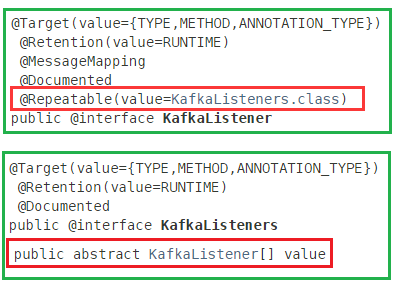Springboot-@KafkaListener 使用方式
2. consumer
使用了@KafkaListener注解。
2.1. pom.xml
引入以下依赖
<dependency>
<groupId>org.springframework.kafka</groupId>
<artifactId>spring-kafka</artifactId>
<version>1.2.0.RELEASE</version>
</dependency>2.2. 配置类
@Configuration
@EnableKafka
public class KafkaConfig {
@Value("${kafka.bootstrap.servers}")
private String kafkaBootstrapServers;
@Value("${session.timeout.ms}")
private Integer sessionTimeoutMs;
@Value("${enable.auto.commit}")
private boolean enableAutoCommit;
@Value("${auto.commit.interval.ms}")
private Integer autoCommitIntervalMs;
@Value("${auto.offset.reset}")
private String autoOffsetReset;
@Value("${group.id}")
private String groupId;
@Bean
KafkaListenerContainerFactory<ConcurrentMessageListenerContainer<Integer, String>> kafkaListenerContainerFactory() {
ConcurrentKafkaListenerContainerFactory<Integer, String> factory = new ConcurrentKafkaListenerContainerFactory<>();
factory.setConsumerFactory(consumerFactory());
factory.setConcurrency(3);
factory.getContainerProperties().setPollTimeout(3000);
return factory;
}
@Bean
public ConsumerFactory<Integer, String> consumerFactory() {
return new DefaultKafkaConsumerFactory<>(consumerConfigs());
}
@Bean
public Map<String, Object> consumerConfigs() {
Map<String, Object> props = new HashMap<>();
props.put(ConsumerConfig.BOOTSTRAP_SERVERS_CONFIG, kafkaBootstrapServers);
props.put(ConsumerConfig.GROUP_ID_CONFIG, groupId);
props.put(ConsumerConfig.ENABLE_AUTO_COMMIT_CONFIG, enableAutoCommit);
props.put(ConsumerConfig.AUTO_COMMIT_INTERVAL_MS_CONFIG, autoCommitIntervalMs);
props.put(ConsumerConfig.SESSION_TIMEOUT_MS_CONFIG, sessionTimeoutMs);
props.put(ConsumerConfig.AUTO_OFFSET_RESET_CONFIG, autoOffsetReset);
props.put(ConsumerConfig.KEY_DESERIALIZER_CLASS_CONFIG, IntegerDeserializer.class);
props.put(ConsumerConfig.VALUE_DESERIALIZER_CLASS_CONFIG, StringDeserializer.class);
return props;
}
@Bean
public KafkaConsumer consumer() {
return new KafkaConsumer();
}
}2.3. 消费处理
public class KafkaConsumer {
@KafkaListeners({@KafkaListener(topics="topic1"), @KafkaListener(topics="topic2")})
public void listen(ConsumerRecord<Integer, String> msg) {
// 消费到数据后的处理逻辑
}
}2.4. @KafkaListener和@KafkaListners
@KafkaListeners是@KafkaListener的Container Annotation,这也是jdk8的新特性之一,注解可以重复标注。
@KafkaListeners({@KafkaListener(topics="topic1"), @KafkaListener(topics="topic2")})
public void listen(ConsumerRecord<Integer, String> msg) {}
等同于
@KafkaListener(topics="topic1")
@KafkaListener(topics="topic2")
public void listen(ConsumerRecord<Integer, String> msg) {}2.5. @KafkaListener使用小结
在注解上可以方便地进行各种配置,但是如果要消费的topic个数不定,用@KafkaListener就很难优雅解决。
注解要求必须在compile-time就能确定值,可以移步stackOverFlow查看更加详细的解释。
@KafkaListener和@KafkaListeners的使用
原文:https://www.cnblogs.com/gxyandwmm/p/11849786.html
Keep moving forwards~



